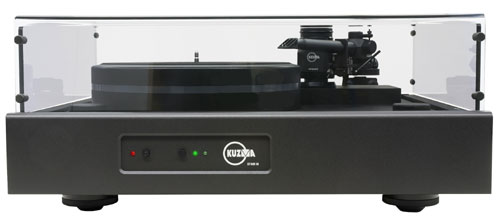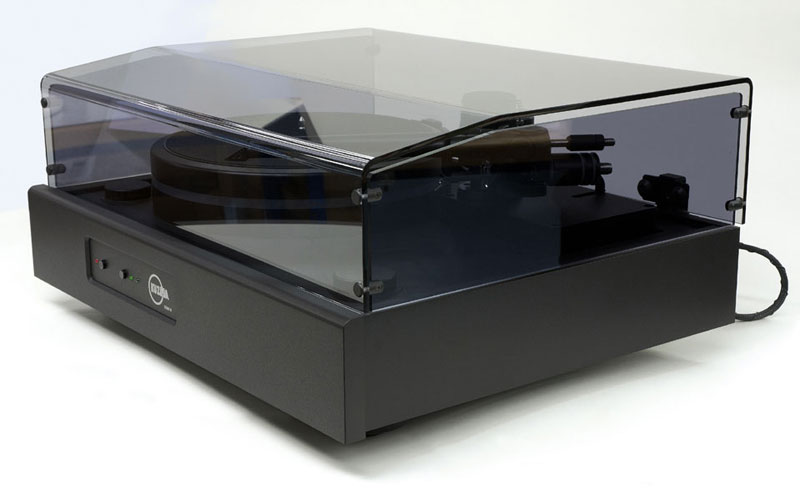Something Wicked This Way Comes: Kuzma Stabi M
The piece in question was the long-awaited (by me, at least) Zanden Model 1300 phono stage, a one-box, half-the-price version of the circuit and switching used in the legendary Model 1200, still one of the best and certainly the most downright beguiling phono stages I’ve ever enjoyed. So it should be no surprise that I was more than a little keen to view the 1300 in the flesh -- and I wasn’t disappointed. The sleek, single chrome chassis oozes all the class that seems to radiate so effortlessly from Zanden products. The four beautifully profiled knobs that are evenly spaced across the front panel offer switching for power and the high- and low-sensitivity inputs, but also the features that make the Zanden phono stages so appealing to me: a range of record replay EQ curves and an absolute phase switch, both crucial if you want to extract the full performance potential of older (and some surprisingly recent) records. With the same all-tube active circuit used in the Model 1200, combined with Jensen step-up transformers and incorporating tube rectification for the power supply, the 1300 also incorporates an LCR circuit for its five equalization curves (RIAA, Teldec, Decca, Columbia and EMI). It’s an enticing prospect that I’m champing at the bit to try -- but it’s also one I didn't get to hear, the review unit having been disconnected and allowed to cool for transport. The surprise came from quite a different quarter. The Audiofreaks system is one I know well, it having been astonishingly stable over the years. The heart of the setup consists of a Conrad-Johnson GAT line stage and a pair of Karan Acoustics KA-M 2000 monoblocks, driving a pair of Avalon Isis loudspeakers via Cardas Clear cabling. The phono stage is (of course) the Zanden Model 1200 Mk III, with everything sat on finite-elemente pagode Master Reference racks. The surprise came in the shape of the turntable. Kuzma was one of Audiofreaks’ original product lines, and they have represented the brand for nearly 30 years. The ‘table that normally sits at the front-end of the "home" system is a Stabi XL4, complete with 4Point tonearm and a Benz LP cartridge -- but not this time. In place of the massive, towering cylindrical presence of the XL4 was a wide, low-slung yet still impressively solid slab of blackness -- the new Stabi M.
As you can see from the pictures, this is one very different -- almost traditional-looking -- turntable. Its broad plinth, total stability and full lid evoke the studio decks of old. The full technical description can wait, but the highlights include:
This is one big, solid, heavy and very, very black turntable -- and yes, black is the only color available. But what’s really impressive about the Stabi M is the way it sounds. Armed with the same 4Point and LP combination usually mounted on the XL4, and playing familiar discs in this familiar system, the music had a clarity, separation and stability reminiscent of master tape -- yet without the almost clinical and slightly mechanical quality that so often marks tape replay. The top-to-bottom linearity and the fluid, unforced tempi were remarkable, removing any sense of the mechanical means of reproduction, the process of playing the record. But what underpinned all of these qualities, allowing them to emerge and also binding them into a single convincing whole, was a ghostly silent background behind and beneath the performance. More than anything else, it was this that allowed such easy identification and separation of instruments and voices, such clearly defined character and tonality. Combined with the ability to hold instruments and whole orchestras in space, even under the most demanding dynamic conditions (okay, so the two kilowatts of power on tap certainly helped) this was one of the most consistently credible and convincing presentations I’ve heard for a long time. And engaging too -- time and again, discussion of exactly what we were hearing lapsed as we were pulled back into the musical performance. But in some respects, the most impressive thing of all is the price. In this age of apparently ever-higher, sky’s-the-limit prices for analog systems, the sticker on the Stabi M reads an almost modest £12,000. I know that’s not exactly small change, but it is considerably less than the flagship XL4’s £19,000 asking price, while offering degrees of versatility and practicality that are unusual to say the least. With a full lid, three electronically adjustable speeds (remote control start/stop for those who don’t want to miss the first few notes) and the ability to accept just about any 'arm, the Stabi M really is the spiritual descendent of decks like the Technics SP15 and Thorens TD 124. More importantly, combined with the superb 4Point tonearm and a cartridge like the Lyra Titan i, Dynavector DRT-XV1s or Benz LP you could put together a genuinely top-flight record replay system for around £20,000 -- or less than the cost of most of the competing turntables, without 'arm and cartridge! Rather like the VPI decks, Kuzmas have an enviable reputation for simply getting on with the job, doing the things that matter and not bothering to incorporate fripperies that don’t. The result is a lot of very reliable performance for the money -- and if first impressions are anything to go by, the Stabi M takes that to a new level. It looks like an early review should be a priority. Hmmm, I wonder if I could get ahold of one while
I’ve still got the Zanden Model 1300 phono stage on hand. |

 ometimes the best
experiences are the ones you aren’t expecting. It’s true of life and it’s
especially true of music and audio. From the live band you just chance across to the bit
of kit that surpasses all expectations, those little surprises are often the sweetest.
Which is exactly what happened the other day, when I visited Audiofreaks, one of the
UK’s most prominent distributors, to collect a unit for review.
ometimes the best
experiences are the ones you aren’t expecting. It’s true of life and it’s
especially true of music and audio. From the live band you just chance across to the bit
of kit that surpasses all expectations, those little surprises are often the sweetest.
Which is exactly what happened the other day, when I visited Audiofreaks, one of the
UK’s most prominent distributors, to collect a unit for review.